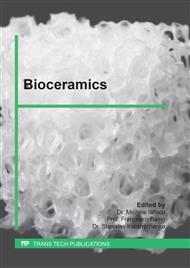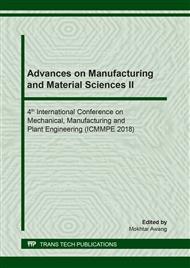[1]
N. A. M. Barakat, M. S. Khil, A. M. Omran, F. A. Sheikh, and H. Y. Kim, Extraction of pure natural hydroxyapatite from the bovine bones bio waste by three different methods,, J. Mater. Process. Technol., vol. 209, no. 7, p.3408–3415, (2009).
DOI: 10.1016/j.jmatprotec.2008.07.040
Google Scholar
[2]
M. Younesi, S. Javadpour, and M. E. Bahrololoom, Effect of heat treatment temperature on chemical compositions of extracted hydroxyapatite from bovine bone ash,, J. Mater. Eng. Perform., vol. 20, no. 8, p.1484–1490, (2011).
DOI: 10.1007/s11665-010-9785-z
Google Scholar
[3]
M. M. Stevens, Biomaterials for bone tissue engineering,, Mater. Today, vol. 11, no. 5, p.18–25, (2008).
Google Scholar
[4]
C. P. Yoganand, V. Selvarajan, J. Wu, and D. Xue, Processing of bovine hydroxyapatite (HA) powders and synthesis of calcium phosphate silicate glass ceramics using DC thermal plasma torch,, Vacuum, vol. 83, no. 2, p.319–325, (2008).
DOI: 10.1016/j.vacuum.2008.06.003
Google Scholar
[5]
R. Murugan and S. Ramakrishna, Production of ultra-fine bioresorbable carbonated hydroxyapatite,, Acta Biomater., vol. 2, no. 2, p.201–206, (2006).
DOI: 10.1016/j.actbio.2005.09.005
Google Scholar
[6]
H. Eslami, M. Solati-Hashjin, and M. Tahriri, The comparison of powder characteristics and physicochemical, mechanical and biological properties between nanostructure ceramics of hydroxyapatite and fluoridated hydroxyapatite,, Mater. Sci. Eng. C, vol. 29, no. 4, p.1387–1398, (2009).
DOI: 10.1016/j.msec.2008.10.033
Google Scholar
[7]
A. Rogina, M. Ivankovic, and H. Ivankovic, Preparation and characterization of nano-hydroxyapatite within chitosan matrix,, Mater. Sci. Eng. C, vol. 33, no. 8, p.4539–4544, (2013).
DOI: 10.1016/j.msec.2013.07.008
Google Scholar
[8]
G. Chen, T. Ushida, and T. Tateishi, Development of biodegradable porous scaffolds for tissue engineering,, Mater. Sci. Eng. C, vol. 17, no. 1–2, p.63–69, (2001).
DOI: 10.1016/s0928-4931(01)00338-1
Google Scholar
[9]
Y. Z. Wan et al., Biomimetic synthesis of hydroxyapatite/bacterial cellulose nanocomposites for biomedical applications,, Mater. Sci. Eng. C, vol. 27, no. 4, p.855–864, (2007).
Google Scholar
[10]
E. Bouyer, F. Gitzhofer, and M. I. Boulos, Morphological study of hydroxyapatite nanocrystal suspension,, J. Mater. Sci. Mater. Med., vol. 11, no. 8, p.523–531, (2000).
Google Scholar
[11]
X. Li, L. Wang, Y. Fan, Q. Feng, F. Z. Cui, and F. Watari, Nanostructured scaffolds for bone tissue engineering,, J. Biomed. Mater. Res. - Part A, vol. 101 A, no. 8, p.2424–2435, (2013).
DOI: 10.1002/jbm.a.34539
Google Scholar
[12]
S. Adzila, S. Ramesh, I. Sopyan, C. Y. Tan, M. Hamdi, and W. D. Teng, Mechanochemical Synthesis of Magnesium Doped Hydroxyapatite: Powder Characterization,, Appl. Mech. Mater., vol. 372, no. January, p.62–65, (2013).
DOI: 10.4028/www.scientific.net/amm.372.62
Google Scholar
[13]
S. V. Dorozhkin, Calcium Orthophosphates as Bioceramics: State of the Art,, J. Funct. Biomater., vol. 1, no. 1, p.22–107, (2010).
Google Scholar
[14]
E. Champion, Sintering of calcium phosphate bioceramics,, Acta Biomater., vol. 9, no. 4, p.5855–5875, (2013).
DOI: 10.1016/j.actbio.2012.11.029
Google Scholar
[15]
N. Bano, S. S. B. Jikan, H. B. Basri, S. A. B. S. A. Bakar, and A. H. Nuhu, Natural Hydroxyapatite Extracted From Bovine Bone,, J. Sci. Technol., vol. 9, no. 2, p.22–28, (2017).
Google Scholar
[16]
M. Figueiredo, J. Henriques, G. Martins, F. Guerra, F. Judas, and H. Figueiredo, Physicochemical characterization of biomaterials commonly used in dentistry as bone substitutes - Comparison with human bone,, J. Biomed. Mater. Res. - Part B Appl. Biomater., vol. 92, no. 2, p.409–419, (2010).
DOI: 10.1002/jbm.b.31529
Google Scholar
[17]
R. Rajesh, A. Hariharasubramanian, and Y. D. Ravichandran, Chicken Bone as a Bioresource for the Bioceramic (Hydroxyapatite),, Phosphorus. Sulfur. Silicon Relat. Elem., vol. 187, no. 8, p.914–925, (2012).
DOI: 10.1080/10426507.2011.650806
Google Scholar
[18]
A. Sobczak, Z. Kowalski, and Z. Wzorek, Preparation of hydroxyapatite from animal bones,, Acta Bioeng. Biomech., vol. 11, no. 4, p.23–28, (2009).
Google Scholar
[19]
K. Haberko et al., Natural hydroxyapatite - Its behaviour during heat treatment,, J. Eur. Ceram. Soc., vol. 26, no. 4–5, p.537–542, (2006).
Google Scholar
[20]
N. Mustafa, M. H. I. Ibrahim, R. Asmawi, and A. M. Amin, Hydroxyapatite extracted fromWaste Fish Bones and Scales via Calcination Method,, Appl. Mech. Mater., vol. 774, p.2–6, (2015).
DOI: 10.4028/www.scientific.net/amm.773-774.287
Google Scholar
[21]
J. Venkatesan et al., Isolation and characterization of nano-hydroxyapatite from salmon fish bone,, Materials (Basel)., vol. 8, no. 8, p.5426–5439, (2015).
DOI: 10.3390/ma8085253
Google Scholar
[22]
A. Ruksudjarit, K. Pengpat, G. Rujijanagul, and T. Tunkasiri, Synthesis and characterization of nanocrystalline hydroxyapatite from natural bovine bone,, Curr. Appl. Phys., vol. 8, no. 3–4, p.270–272, (2008).
DOI: 10.1016/j.cap.2007.10.076
Google Scholar
[23]
C. Y. Ooi, M. Hamdi, and S. Ramesh, Properties of hydroxyapatite produced by annealing of bovine bone,, Ceram. Int., vol. 33, no. 7, p.1171–1177, (2007).
DOI: 10.1016/j.ceramint.2006.04.001
Google Scholar
[24]
N. A. M. Barakat et al., Physiochemical characterizations of hydroxyapatite extracted from bovine bones by three different methods: Extraction of biologically desirable HAp,, Mater. Sci. Eng. C, vol. 28, no. 8, p.1381–1387, (2008).
DOI: 10.1016/j.msec.2008.03.003
Google Scholar
[25]
M. Akram, R. Ahmed, I. Shakir, W. A. W. Ibrahim, and R. Hussain, Extracting hydroxyapatite and its precursors from natural resources,, J. Mater. Sci., vol. 49, no. 4, p.1461–1475, (2014).
DOI: 10.1007/s10853-013-7864-x
Google Scholar
[26]
S. M. Londoño-Restrepo, C. F. Ramirez-Gutierrez, A. Del Real, E. Rubio-Rosas, and M. E. Rodriguez-García, Study of bovine hydroxyapatite obtained by calcination at low heating rates and cooled in furnace air,, J. Mater. Sci., p.1–11, (2016).
DOI: 10.1007/s10853-016-9755-4
Google Scholar
[27]
A. Doostmohammadi, A. Monshi, M. H. Fathi, and O. Braissant, A comparative physico-chemical study of bioactive glass and bone-derived hydroxyapatite,, Ceram. Int., vol. 37, no. 5, p.1601–1607, (2011).
DOI: 10.1016/j.ceramint.2011.03.009
Google Scholar
[28]
F.-H. Lin, C.-J. Liao, K.-S. Chen, and J.-S. Sun, Preparation of a biphasic porous bioceramic by heating bovine cancellous bone with Na4P2O7. 10H2O addition,, Biomaterials, vol. 20, no. 5, p.475–484, (1999).
DOI: 10.1016/s0142-9612(98)00193-8
Google Scholar
[29]
E. Hosseinzadeh, M. Davarpanah, N. H. Nemati, and S. A. Tavakoli, Fabrication of a hard tissue replacement using natural hydroxyapatite derived from bovine bones by thermal decomposition method,, Int. J. Organ Transplant. Med., vol. 5, no. 1, p.23–31, (2014).
Google Scholar
[30]
B. Cengiz, Y. Gokce, N. Yildiz, Z. Aktas, and A. Calimli, Synthesis and characterization of hydroxyapatite nanoparticles,, Colloids Surfaces A Physicochem. Eng. Asp., vol. 322, no. 1–3, p.29–33, (2008).
DOI: 10.1016/j.colsurfa.2008.02.011
Google Scholar
[31]
E. Landi, E. Landi, A. Tampieri, G. Celotti, and S. Sprio, Densification Behavior and Mechanisms of Synthetic Hydroxyapatite,, J. Eur. Ceram. Soc., vol. 20, no. 14–15, p.2377–2387, (2000).
DOI: 10.1016/s0955-2219(00)00154-0
Google Scholar
[32]
M. Figueiredo, A. Fernando, G. Martins, J. Freitas, F. Judas, and H. Figueiredo, Effect of the calcination temperature on the composition and microstructure of hydroxyapatite derived from human and animal bone,, Ceram. Int., vol. 36, no. 8, p.2383–2393, (2010).
DOI: 10.1016/j.ceramint.2010.07.016
Google Scholar



